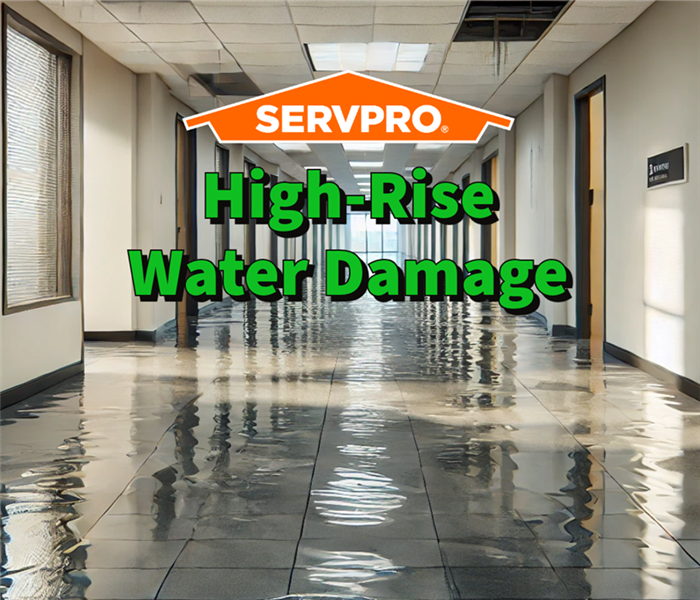High-Rise Water Damage: The Top 5 Risks & Expert Solutions
3/24/2025 (Permalink)
This in-depth guide on high-rise water damage explores its unique challenges, preventive measures, and how SERVPRO® ensures expert restoration for multi-story buildings.
High-rise buildings present unique challenges when it comes to water damage. Whether it’s a luxury condominium, an office tower, or a commercial high-rise, water damage can spread quickly between floors, affecting multiple units and causing significant structural and financial losses.
This blog post will summarize the most common causes of high-rise water damage, offer essential prevention strategies, and showcase how SERVPRO can provide expert restoration services to protect your property.
What Causes High-Rise Water Damage?
High-rise water damage can occur due to various factors, but some of the most common include:
- Plumbing Failures: Burst pipes, leaks in water supply lines, and faulty fixtures can lead to extensive water damage, impacting multiple floors simultaneously.
- HVAC System Malfunctions: Improper drainage or blocked condensate lines in commercial HVAC systems can lead to water pooling and structural damage.
- Sprinkler System Leaks: High-rise buildings require extensive fire suppression systems, and even a minor leak in a sprinkler system can flood entire sections of the building.
- Roof Leaks & Window Failures: Water intrusion from a damaged roof or improperly sealed windows can allow rainwater to seep into the upper floors and travel downward.
- Appliance & Equipment Failures: Malfunctions in water-dependent appliances such as dishwashers, water heaters, and washing machines can result in widespread damage.
How Can Plumbing Failures Lead to Structural Damage?
The effects can be catastrophic when a pipe bursts in a high-rise building. Water can travel downwards through walls, ceilings, and flooring, causing damage to multiple units in a short amount of time.
Beyond structural damage, water can impact electrical systems, leading to power outages or even fire hazards. The longer the water remains unaddressed, the more severe the consequences, including weakened structural integrity and costly repairs.
Tips to Prevent High-Rise Water Damage
Preventing high-rise water damage requires proactive building management. Below are expert-recommended measures to safeguard your property:
- Schedule Regular Plumbing Inspection: Conduct routine checks on pipes, valves, and fixtures to detect and address leaks before they escalate.
- Maintain HVAC and Sprinkler Systems: Ensure proper maintenance of HVAC systems and test sprinkler lines to prevent unexpected leaks.
- Upgrade Building Drainage Systems: To minimize flood risks, install proper drainage systems—including sump pumps and backflow preventers.
- Waterproof Vulnerable Areas: Seal roofs, windows, and exterior walls to prevent water intrusion from heavy rainfall or storms.
- Install Water Detection Devices: Smart sensors and automatic shut-off valves can help detect leaks early and prevent large-scale water damage.
- Educate Tenants and Property Managers: Establish protocols for identifying and reporting leaks immediately to prevent further damage.
A Recent High-Rise Water Damage Emergency in Dayton, Ohio
Last month, SERVPRO responded to an urgent call from a high-rise office complex in Dayton, Ohio. The building’s fire sprinkler system malfunctioned on the 12th floor, sending thousands of gallons of water cascading down multiple floors, affecting several businesses and residential units.
Upon receiving the call, our SERVPRO team arrived on-site within hours to begin restoration. Here’s how we handled this complex situation:
- Emergency Water Extraction: We rapidly removed standing water from the affected floors using industrial-grade extraction pumps to minimize further damage.
- Structural Drying & Dehumidification: Our team deployed high-powered air movers and dehumidifiers to eliminate hidden moisture trapped in walls, ceilings, and flooring.
- Moisture Mapping & Damage Assessment: We utilized infrared cameras and moisture meters to identify affected areas and develop a comprehensive drying plan.
- Restoration & Repairs: After drying the structure, we repaired damaged drywall, replaced carpeting, and restored the affected offices and residential units to pre-damage conditions.
- Preventative Recommendations: Finally, we worked with building management to implement preventive measures, including routine sprinkler maintenance and installing water leak detection systems.
This situation in Dayton, Ohio, demonstrated the importance of a rapid response. Without immediate action, the water could have continued spreading, leading to even more significant structural damage and business disruptions.
What to Do If Your High-Rise Property Experiences Water Damage
If your high-rise building experiences water damage, take these immediate steps to minimize losses:
- Shut off the water source (if possible) to prevent further flooding.
- Contact SERVPRO for 24/7 emergency restoration services.
- Document the damage by taking photos and videos for insurance purposes.
- Begin temporary water extraction efforts if it is safe to do so.
- Evacuate affected areas to ensure tenant and occupant safety.
Conclusion
SERVPRO specializes in high-rise water damage restoration, offering rapid response and expert solutions to protect commercial and residential properties. With advanced drying technology, industry-leading expertise, and a commitment to restoring properties to preloss conditions, SERVPRO is your trusted partner in water damage recovery.
High-rise buildings are uniquely vulnerable to water damage. Still, with proactive prevention and immediate action when incidents occur, property owners can mitigate risks and minimize costly repairs. If your high-rise property experiences water damage, trust SERVPRO to provide expert restoration services and ensure a swift recovery.
Contact SERVPRO today to safeguard your property against high-rise water damage and experience the industry’s leading restoration services.



 24/7 Emergency Service
24/7 Emergency Service